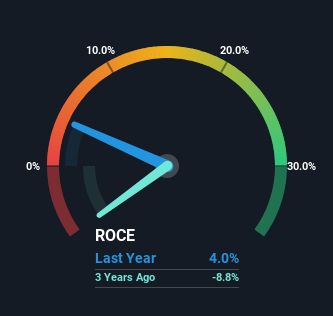Hoe Leong (SGX:H20) Shareholders Will Want The ROCE Trajectory To Continue
What are the early trends we should look for to identify a stock that could multiply in value over the long term? Typically, we'll want to notice a trend of growing return on capital employed (ROCE) and alongside that, an expanding base of capital employed. This shows us that it's a compounding machine, able to continually reinvest its earnings back into the business and generate higher returns. So when we looked at Hoe Leong (SGX:H20) and its trend of ROCE, we really liked what we saw.
Return On Capital Employed (ROCE): What Is It?
For those who don't know, ROCE is a measure of a company's yearly pre-tax profit (its return), relative to the capital employed in the business. To calculate this metric for Hoe Leong, this is the formula:
Return on Capital Employed = Earnings Before Interest and Tax (EBIT) ÷ (Total Assets - Current Liabilities)
0.04 = S$1.2m ÷ (S$45m - S$15m) (Based on the trailing twelve months to December 2023).
Therefore, Hoe Leong has an ROCE of 4.0%. In absolute terms, that's a low return and it also under-performs the Machinery industry average of 6.9%.
Check out our latest analysis for Hoe Leong

While the past is not representative of the future, it can be helpful to know how a company has performed historically, which is why we have this chart above. If you'd like to look at how Hoe Leong has performed in the past in other metrics, you can view this free graph of Hoe Leong's past earnings, revenue and cash flow.
What Does the ROCE Trend For Hoe Leong Tell Us?
It's great to see that Hoe Leong has started to generate some pre-tax earnings from prior investments. The company was generating losses five years ago, but now it's turned around, earning 4.0% which is no doubt a relief for some early shareholders. Additionally, the business is utilizing 30% less capital than it was five years ago, and taken at face value, that can mean the company needs less funds at work to get a return. Hoe Leong could be selling under-performing assets since the ROCE is improving.
What We Can Learn From Hoe Leong's ROCE
From what we've seen above, Hoe Leong has managed to increase it's returns on capital all the while reducing it's capital base. And since the stock has fallen 67% over the last five years, there might be an opportunity here. That being the case, research into the company's current valuation metrics and future prospects seems fitting.
On a final note, we found 3 warning signs for Hoe Leong (1 shouldn't be ignored) you should be aware of.
For those who like to invest in solid companies, check out this free list of companies with solid balance sheets and high returns on equity.
Valuation is complex, but we're here to simplify it.
Discover if Hoe Leong might be undervalued or overvalued with our detailed analysis, featuring fair value estimates, potential risks, dividends, insider trades, and its financial condition.
Access Free AnalysisHave feedback on this article? Concerned about the content? Get in touch with us directly. Alternatively, email editorial-team (at) simplywallst.com.
This article by Simply Wall St is general in nature. We provide commentary based on historical data and analyst forecasts only using an unbiased methodology and our articles are not intended to be financial advice. It does not constitute a recommendation to buy or sell any stock, and does not take account of your objectives, or your financial situation. We aim to bring you long-term focused analysis driven by fundamental data. Note that our analysis may not factor in the latest price-sensitive company announcements or qualitative material. Simply Wall St has no position in any stocks mentioned.
About SGX:H20
Hoe Leong
An investment holding company, designs, manufactures, and distributes heavy equipment parts in Australia, North America, Asia, Europe, the Middle East, and internationally.
Flawless balance sheet and good value.
Market Insights
Community Narratives



